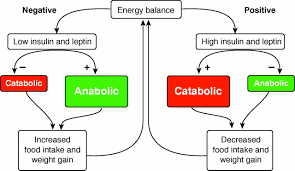 Energy homeostasis, or the homeostatic control of energy balance, is a biological process that involves the coordinated homeostatic regulation of food intake (energy inflow) and energy expenditure (energy outflow).
Energy homeostasis, or the homeostatic control of energy balance, is a biological process that involves the coordinated homeostatic regulation of food intake (energy inflow) and energy expenditure (energy outflow).
The human brain, particularly the hypothalamus, plays a central role in regulating energy homeostasis and generating the sense of hunger by integrating a number of biochemical signals that transmit information about energy balance.
Fifty percent of the energy from glucose metabolism is immediately converted to heat.
Biological energy is expressed using the energy unit Calorie, which equals the energy needed to increase the temperature of 1 kilogram of water by 1 °C or about 4.18 kJ.
Energy can be neither created nor destroyed, but energy can be converted from one form of energy to another.
When a calorie of food energy is consumed, one of three particular effects occur within the body: a portion of that calorie may be stored as body fat, triglycerides, or glycogen, transferred to cells and converted to chemical energy in the form of adenosine triphosphate (ATP – a coenzyme) or related compounds, or dissipated as heat.
Energy intake is measured by the amount of calories consumed from food and fluids.
Energy intake is modulated by hunger, which is primarily regulated by the hypothalamus, and choice, which is determined by the sets of brain structures that are responsible for stimulus control and cognitive control of eating behavior.
Hunger is regulated in part by the action of certain peptide hormones and neuropeptides-insulin, leptin, ghrelin, and neuropeptide Y in the hypothalamus.
Energy expenditure is mainly a sum of internal heat produced and external work.
The internal heat produced is the sum of basal metabolic rate (BMR) and the thermic effect of food.
External work may be estimated by measuring the physical activity level.
The body cannot precisely compensate for errors in energy/calorie intake, and potentially explains both weight loss and weight gain such as obesity.
A positive balance is a result of energy intake being higher than what is consumed in external work and other bodily means of energy expenditure.
The main preventable causes of a positive energy balance:
Overeating, resulting in increased energy intake
Sedentary lifestyle, resulting in decreased energy expenditure through external work
A positive balance results in energy being stored as fat and/or muscle, causing weight gain. In time, overweight and obesity may develop, with resultant complications.
A negative balance is a result of energy intake being less than what is consumed in external work and other bodily means of energy expenditure.
The main cause is undereating due to a medical condition: decreased appetite, anorexia nervosa, digestive disease, or due to some circumstance such as fasting or lack of access to food.
Hyperthyroidism can also be a cause of negative energy balance.
One’s normal energy requirement, and therefore normal energy intake, depends mainly on age, sex and physical activity level.
While is still not certain if calorie restriction has a positive effect on longevity for humans it may be viewed as attaining energy balance at a lower intake and expenditure, and is, in this sense, not generally an energy imbalance, except for an initial imbalance where decreased expenditure hasn’t yet matched the decreased intake.
